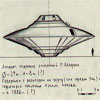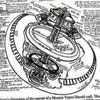Space Ships And Gravity
As the Earthman plans voyages into outer space, he is faced to a certain degree with problems comparable in many ways to those of the ancient mariner, for throughout space there are definite natural lanes, just as the oceans have their currents. Our pilots have found “rivers in space” above our planet as they were flying at certain altitudes. These were located by chance, but since have been described in numerous articles published in aviation magazines. Our scientists and our airmen are aware of various types of currents moving through the atmosphere, comparable to those of the oceans. We will find similar conditions throughout all space, between planets and systems.
As they studied such conditions in the atmospheres encompassing their own planets, inhabitants of other worlds were able to develop their first ships enabling them to venture into outer space. Since that time space has become as safe and simple for them to travel as the atmosphere through which our planes fly from place to place on Earth. They quickly realized that if they were to go out and return safely home, they could not burden their ships with heavy loads of fuel, but would have to learn how to use Nature’s energy for their propulsion power. So it was along these lines that their scientists worked, and finally succeeded.
To understand more clearly the magnetic propulsion of interplanetary spacecraft, we must first consider geomagnetism, the magnetic sphere of influence which surrounds every planet and every sun, filling all space.
We can liken Earth’s geomagnetic field to the series of circular ripples created by dropping a pebble into a pond. These circular ripples move outward from the center point where the pebble was dropped; expanding in size, but diminishing in force as they move.
If we simultaneously drop two pebbles into the pond, several feet apart, two sets of expanding circular waves are created, moving outward from each central point. Where the wave fronts meet, an interference pattern is formed which extends between the two center points.
This interference pattern assumes the shape of an extended ellipse, with its smaller ends at the points where the pebbles were dropped. Although both wave fronts have diminished in force as they traveled outward from their central points, the interference pattern has combined a portion of both forces to create a third force, which remains constant between the two central points so long as they remain active.
The same relationship exists between the expanding spheres of magnetic influence which move into space from the sun, and from each planet or satellite. As these magnetic wave fronts expand from another source, they form a magnetic interference pattern which again assumes the general shape of an extended ellipse. Although the geomagnetic field of each planet or sun diminishes in strength as it moves spaceward, the elliptical magnetic fields thus created between celestial bodies by magnetic interferences maintain a constant-strength magnetic field between the bodies.
A planet’s magnetic field is similar to “direct current,” which grows weaker as it travels from its source; however, the elliptical magnetic field shared by two planets may be likened to “alternating current,” which can be transmitted over long distances.
These alternating elliptical fields, extending from sun to planet, and from planet to planet, are the invisible bonds which balance the Solar System. They extend in similar fashion between systems, and between galaxies. They also exist between the micro-magnetic fields of atoms, the “miniature solar systems.”
The “end zones” of elliptical fields which influence Earth extend from about 58 degrees north latitude to 58 degrees south latitude. The axis of each elliptical field is at right angles to the magnetic polar axis, and the elliptical field axis corresponds to Earth’s magnetic equator.
The “magnetic rivers” between planets constantly alternate or change their direction of flow, creating a two-way magnetic pulse between planets. By using only one half of each two-way pulse, space liners move in one direction. For example, if the spacecraft uses only an outward pulse, it moves away from a planet. If the ship uses an inward pulse, it moves toward a planet. If the spacecraft allows the alternating pulse to flow through it in both directions, it can hover.
To explain how the space ships operate within a planet’s gravitational field, we must first recognize the relationship between geomagnetism and the planet’s rotation.
On Earth many writers have referred to “anti-gravity” devices, and in our scientific researches the idea has been introduced that gravity can be wrestled to a standstill. This is not an efficient approach.
Space ships that today are visiting our world from other planets operate on a “pro-gravitic” principle, using the natural forces, instead of attempting to fight them. Since these ships operate on electrostatic power, it would be useless for them to fight the geomagnetic forces, since Earth’s geomagnetic field alone has an electrical potential of billions of volts.
Planetary gravity is the natural balance between the centrifugal force of a planet’s axial velocity and the centripetal attraction of its electrostatic field. Centrifugal force tries to spin an object from the planet’s surface, but electrostatic attraction keeps the object from flying into space.
If electrostatic attraction did not exist, we would have to hang firmly to a tree or rock to keep from being hurled into space by centrifugal force. By the same token, if centrifugal force did not exist to balance electrostatic attraction and its inward centripetal force, we would be flattened against the earth’s surface.
I believe the late Dr. Albert Einstein described this balanced, inseparable relationship in his Unified Field Theory; however, my observations are not so profound as those achieved by that great abstract scientist.
We have briefly challenged the gravitational force with our aircraft and rockets. Now it is time to consider the benefits we can derive from putting that force to work for us.
A rocket is pushed forward by a concentrated chemical thrust that is greater than the pull of gravity. The “ionic rockets” we are now planning will expel ions out of their engines and achieve thrust exactly like the chemical rockets. Ionic rockets, however, can not operate efficiently within the unified field of a planet. They are only efficient in the near-vacuum of outer space.
A flying saucer, or “pro-gravitic” craft, operates by generating its own gravitational field, which surrounds it in a generally spherical pattern. This field is adjusted to resonate, or blend in harmony with the planet’s geomagnetic field. The resonating gravitational field causes the ship to be weightless. In this weightless or balanced condition, the ship, wherever it may be, can be moved by a relatively slight thrust.
Our ionic rockets are designed to exert the electrical thrust of ionized particles, a thrust so relatively small it has been termed slight as “a butterfly’s sigh.” In outer space, however, where the ionic rocket would be “weightless,” because it would be free of planetary gravity, this tiny “sigh” of ionic power could propel the rocket at speeds eventually reaching three million miles per hour, according to present theory.
Within its self-generated pro-gravitic field, the saucer can travel at a rate exceeding the speed of light! Using the forces of Nature, its movement can be the same as that of natural forces. The propelling power as produced by the generator within the spacecraft can be compared to that provided by the Van de Graaff electrostatic generators which are used in our own physics laboratories.
An interesting laboratory demonstration which simulates the effect of a hovering saucer can be achieved by placing an aluminum ring over the vertical core of a large electromagnet. By passing an alternating current through the electromagnet, controlled with a rheostat, the aluminum ring can be made to hover. The saucers, however, generate their own resonating fields, instead of “floating” on magnetic eddy currents as in the case of the aluminum ring.
Electrostatic thrust can be demonstrated by placing a tiny strip of aluminum foil near the discharge globe of a Van de Graaff generator. The foil will orbit the discharge globe, with no mechanical connection!
Saucers have often been described as “glowing.” Such a condition is created when natural particles in space, through which a ship is moving, come into contact with its encompassing field of resonant frequency. Pulsations within this field cause a shimmering effect, like heat waves rising from pavement, which makes the craft appear to be “alive and breathing.” This effort can also bend the light waves entirely around the craft, causing it to suddenly disappear from view, though it is actually still there, and not “dematerialized,” as some individuals would have one believe. There is also another explanation of these sudden disappearances. As the field strength is varied, ionization may shift through every color of the spectrum. Increased energy causes the field to shift up past the visible portion of the spectrum, obscuring the craft from view, the same as a heavy cloud bank obscures a plane.
The intense resonating field also serves as a shield to deflect space debris from the ship. At the same time a blend is automatically set up between this field and atmosphere or space through which a spacecraft may be moving, thus preventing friction of any kind. Because of this pro-gravitic nature in its operation, occupants of a space ship are not affected by any violent maneuver or uncomfortable atmospheric conditions.
To travel at speeds faster than light, the ship’s field is tuned to a high resonant point and the craft achieves “prime merge.” For this, the ship is equipped with an automatic robot detector and control system, designed with provisions for manual control.
Contrary to accepted theories, matter is not converted to pure energy under such conditions. A ship within its force field can be compared to a planet within its atmosphere, moving as a unit through space. So, when a space ship accelerates and seems to disappear, it has merely achieved prime merge and its force field is vibrating at a speed faster than visible light. At higher frequencies it may become transparent to radar signals also.
The “hole” effect seen in many saucer photos is created by a “magnetic window.” One small portion of the ship’s force field is neutralized, permitting visual and radar-type observation. At times this is necessary when the force field of the craft is at a fairly high resonance.
The three-ball undercarriage seen on most saucers serves both as a retractable landing gear and as a “three-point electro-static propulsion-control system.” The mother ships use a series of bands built into the framework for the same control purpose. As we use retro-rockets to steer a rocket vehicle, the saucers use their variable three-point systems to maneuver by regulating the charge.
In horizontal flight within a planet’s ionosphere, saucers travel along the planet’s geomagnetic lines of force. They turn abruptly by shifting the ball-charge. In this way they are guided into and utilize the eddy currents found throughout space. A change of direction in the movement of a spacecraft may appear as a sudden 90-degree turn, or any of the erratic maneuvers so often ascribed to the saucers.
One important factor that our engineers for spacecraft will have to take into consideration is the multiple-wall construction required for safety purposes, as well as storage room for a large percentage of their propulsion equipment. There must be a minimum of two charged walls. The outer, negative wall comes in direct contact with the protective force field created around the ship. By its very nature this electrostatic force field ionizes all particles of matter near the ship’s surface, and negatively charges space debris coming within its field of influence. The greater amount of power used, the farther this influence extends from the ship.
A positive reference field is established in an inner wall, leaving the central portion of the ship at a neutral potential.
Important too is an automatic filtering and air-conditioning system installed between walls of a ship to purify the air and keep temperatures and pressures within the craft at a comfortable state for all persons aboard.
Actually, there is not too much difference between modern spacecraft and our own submarines that can surface on the water where outside pressures are light, or go to great depths where pressures against the ship are intense. At any depth a submarine can maneuver at will, without harm or discomfort to its occupants. So it is with a space ship. In outer space the pressures against it are light. When it enters a planet’s ionosphere and approaches the planet, pressures intensify. Yet, wherever it is, it can maneuver at will without harm or discomfort to its occupants.
As our submarine navigators have had to become acquainted with the many rivers flowing beneath the surface of the ocean, so our space navigators will have to learn the magnetic lanes of outer space, as well as those between a planet and its ionosphere. Temperatures, flow and currents throughout the Cosmos vary continually, in repeated patterns. These space lanes will have to be used for direction of travel, and the energy they generate will have to be converted into propulsion power if we ever hope to safely travel and enjoy interplanetary relationships with our neighbors on other planets.
Excerpt from Flying Saucers Farewell
Posted in Science For The New Agewith comments disabled.






